
- Bioactive Compounds
- By Signaling Pathways
- PI3K/Akt/mTOR
- Epigenetics
- Methylation
- Immunology & Inflammation
- Protein Tyrosine Kinase
- Angiogenesis
- Apoptosis
- Autophagy
- ER stress & UPR
- JAK/STAT
- MAPK
- Cytoskeletal Signaling
- Cell Cycle
- TGF-beta/Smad
- Compound Libraries
- Popular Compound Libraries
- Customize Library
- Clinical and FDA-approved Related
- Bioactive Compound Libraries
- Inhibitor Related
- Natural Product Related
- Metabolism Related
- Cell Death Related
- By Signaling Pathway
- By Disease
- Anti-infection and Antiviral Related
- Neuronal and Immunology Related
- Fragment and Covalent Related
- FDA-approved Drug Library
- FDA-approved & Passed Phase I Drug Library
- Preclinical/Clinical Compound Library
- Bioactive Compound Library-I
- Bioactive Compound Library-II
- Kinase Inhibitor Library
- Express-Pick Library
- Natural Product Library
- Human Endogenous Metabolite Compound Library
- Alkaloid Compound LibraryNew
- Angiogenesis Related compound Library
- Anti-Aging Compound Library
- Anti-alzheimer Disease Compound Library
- Antibiotics compound Library
- Anti-cancer Compound Library
- Anti-cancer Compound Library-Ⅱ
- Anti-cancer Metabolism Compound Library
- Anti-Cardiovascular Disease Compound Library
- Anti-diabetic Compound Library
- Anti-infection Compound Library
- Antioxidant Compound Library
- Anti-parasitic Compound Library
- Antiviral Compound Library
- Apoptosis Compound Library
- Autophagy Compound Library
- Calcium Channel Blocker LibraryNew
- Cambridge Cancer Compound Library
- Carbohydrate Metabolism Compound LibraryNew
- Cell Cycle compound library
- CNS-Penetrant Compound Library
- Covalent Inhibitor Library
- Cytokine Inhibitor LibraryNew
- Cytoskeletal Signaling Pathway Compound Library
- DNA Damage/DNA Repair compound Library
- Drug-like Compound Library
- Endoplasmic Reticulum Stress Compound Library
- Epigenetics Compound Library
- Exosome Secretion Related Compound LibraryNew
- FDA-approved Anticancer Drug LibraryNew
- Ferroptosis Compound Library
- Flavonoid Compound Library
- Fragment Library
- Glutamine Metabolism Compound Library
- Glycolysis Compound Library
- GPCR Compound Library
- Gut Microbial Metabolite Library
- HIF-1 Signaling Pathway Compound Library
- Highly Selective Inhibitor Library
- Histone modification compound library
- HTS Library for Drug Discovery
- Human Hormone Related Compound LibraryNew
- Human Transcription Factor Compound LibraryNew
- Immunology/Inflammation Compound Library
- Inhibitor Library
- Ion Channel Ligand Library
- JAK/STAT compound library
- Lipid Metabolism Compound LibraryNew
- Macrocyclic Compound Library
- MAPK Inhibitor Library
- Medicine Food Homology Compound Library
- Metabolism Compound Library
- Methylation Compound Library
- Mouse Metabolite Compound LibraryNew
- Natural Organic Compound Library
- Neuronal Signaling Compound Library
- NF-κB Signaling Compound Library
- Nucleoside Analogue Library
- Obesity Compound Library
- Oxidative Stress Compound LibraryNew
- Plant Extract Library
- Phenotypic Screening Library
- PI3K/Akt Inhibitor Library
- Protease Inhibitor Library
- Protein-protein Interaction Inhibitor Library
- Pyroptosis Compound Library
- Small Molecule Immuno-Oncology Compound Library
- Mitochondria-Targeted Compound LibraryNew
- Stem Cell Differentiation Compound LibraryNew
- Stem Cell Signaling Compound Library
- Natural Phenol Compound LibraryNew
- Natural Terpenoid Compound LibraryNew
- TGF-beta/Smad compound library
- Traditional Chinese Medicine Library
- Tyrosine Kinase Inhibitor Library
- Ubiquitination Compound Library
-
Cherry Picking
You can personalize your library with chemicals from within Selleck's inventory. Build the right library for your research endeavors by choosing from compounds in all of our available libraries.
Please contact us at info@selleckchem.com to customize your library.
You could select:
- Antibodies
- Bioreagents
- qPCR
- 2x SYBR Green qPCR Master Mix
- 2x SYBR Green qPCR Master Mix(Low ROX)
- 2x SYBR Green qPCR Master Mix(High ROX)
- Protein Assay
- Protein A/G Magnetic Beads for IP
- Anti-DYKDDDDK Tag magnetic beads
- Anti-DYKDDDDK Tag Affinity Gel
- Anti-Myc magnetic beads
- Anti-HA magnetic beads
- Poly DYKDDDDK Tag Peptide lyophilized powder
- Protease Inhibitor Cocktail
- Protease Inhibitor Cocktail (EDTA-Free, 100X in DMSO)
- Phosphatase Inhibitor Cocktail (2 Tubes, 100X)
- Cell Biology
- Cell Counting Kit-8 (CCK-8)
- Animal Experiment
- Mouse Direct PCR Kit (For Genotyping)
- New Products
- Contact Us
Ferroptosis Inhibitors/Activators | Chemicals | Inducers | Modulators
Ferroptosis Products
- All (45)
- Ferroptosis Inhibitors (23)
- Ferroptosis Activators (16)
- Ferroptosis Modulator (1)
- New Ferroptosis Products
| Cat.No. | Product Name | Information | Product Use Citations | Product Validations |
|---|---|---|---|---|
| S1166 | Cisplatin | Cisplatin is an inorganic platinum complex, which is able to inhibit DNA synthesis by conforming DNA adducts in tumor cells. Cisplatin activates ferroptosis and induces autophagy.Solutions are unstable and should be fresh-prepared.DMSO is not recommended to dissolve platinum-based drugs, which can easily lead to drug inactivation. |
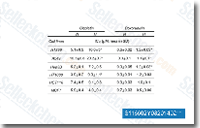
|
|
| S7397 | Sorafenib (BAY 43-9006) | Sorafenib is a multikinase inhibitor of Raf-1 and B-Raf with IC50 of 6 nM and 22 nM in cell-free assays, respectively. Sorafenib inhibits VEGFR-2, VEGFR-3, PDGFR-β, Flt-3 and c-KIT with IC50 of 90 nM, 20 nM, 57 nM, 59 nM and 68 nM, respectively. Sorafenib induces autophagy and apoptosis and activates ferroptosis with anti-tumor activity. |
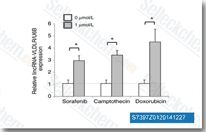
|
|
| S2111 | Lapatinib | Lapatinib is a potent EGFR and ErbB2 inhibitor with IC50 of 10.8 and 9.2 nM in cell-free assays, respectively. This compound induces ferroptosis and autophagic cell death. |
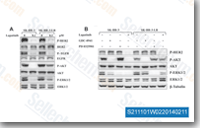
|
|
| S7243 | Ferrostatin-1 (Fer-1) | Ferrostatin-1 (Fer-1) is a potent and selective inhibitor of ferroptosis with EC50 of 60 nM. |
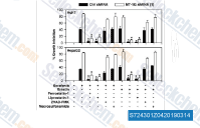
|
|
| S7242 | Erastin | Erastin is a ferroptosis activator by acting on mitochondrial VDAC, exhibiting selectivity for tumor cells bearing oncogenic RAS. Solutions are unstable and should be fresh-prepared. |
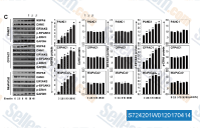
|
|
| S8155 | RSL3 | RSL3 ((1S,3R)-RSL3) is a ferroptosis activator in a VDAC-independent manner,exhibiting selectivity for tumor cells bearing oncogenic RAS. RSL3 binds, inactivates GPX4 and thus mediates GPX4-regulated ferroptosis. |

|
|
| S1040 | Sorafenib tosylate | Sorafenib tosylate is a multikinase inhibitor of Raf-1 and B-Raf with IC50 of 6 nM and 22 nM in cell-free assays, respectively. This compound inhibits VEGFR-2, VEGFR-3, PDGFR-β, Flt-3 and c-KIT with IC50 of 90 nM, 20 nM, 57 nM, 59 nM and 68 nM, respectively. It induces autophagy and apoptosis and activates ferroptosis with anti-tumor activity. |
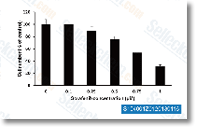
|
|
| S7699 | Liproxstatin-1 | Liproxstatin-1 is a potent ferroptosis inhibitor with an IC50 of 22 nM. |
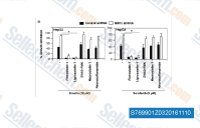
|
|
| S1077 | SB202190 | SB202190 is a potent p38 MAPK inhibitor targeting p38α/β with IC50 of 50 nM/100 nM in cell-free assays, sometimes used instead of SB 203580 to investigate potential roles for SAPK2a/p38 in vivo. This compound inhibits endothelial cell apoptosis via induction of autophagy and heme oxygenase-1. It significantly suppresses Erastin‐dependent ferroptosis. |
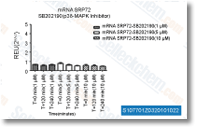
|
|
| S1623 | Acetylcysteine (N-Acetylcysteine, NAC) | Acetylcysteine (N-acetyl-l-cysteine, NAC,N-acetylcysteine) is a ROS(reactive oxygen species) inhibitor that antagonizes the activity of proteasome inhibitors. It is also a tumor necrosis factor production inhibitor. Acetylcysteine(N-acetyl-l-cysteine) suppresses TNF-induced NF-κB activation through inhibition of IκB kinases. Acetylcysteine(N-acetyl-l-cysteine) induces apoptosis via the mitochondria-dependent pathway. Acetylcysteine(N-acetyl-l-cysteine) inhibits ferroptosis and virus replication.Solutions are unstable and should be fresh-prepared. |
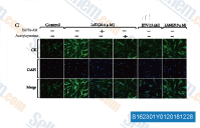
|
|
| S8790 | ML385 | ML385 is a novel and specific NRF2 inhibitor with an IC50 of 1.9 μM. It inhibits the downstream target gene expression of NRF2. This compound regulates the activity of several ferroptosis and lipid peroxidation-related proteins. | ||
| S1007 | Roxadustat (FG-4592) | Roxadustat (FG-4592) is an HIF-α prolyl hydroxylase inhibitor in a cell-free assay, stabilizes HIF-2 and induces EPO production. Roxadustat potentiates RSL3 induced ferroptosis. Phase 3. |
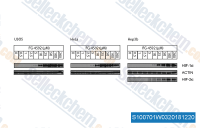
|
|
| S5742 | Deferoxamine mesylate | Deferoxamine mesylate is the mesylate salt of Deferoxamine, which forms iron complexes and is used as a chelating agent. Deferoxamine is a ferroptosis inhibitor that stabilizes HIF-1α expression and improves HIF-1α transactivity in hypoxic and hyperglycemic states in vitro. Deferoxamine decreases beta-amyloid (Aβ) deposition and induces autophagy.Please do not prepare stock solutions with normal saline or PBS, as precipitation may occur. | ||
| S1792 | Simvastatin | Simvastatin is a competitive inhibitor of HMG-CoA reductase with Ki of 0.1-0.2 nM in cell-free assays. Simvastatin induces ferroptosis, mitophagy, autophagy and apoptosis. |
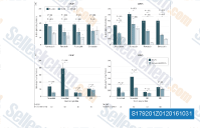
|
|
| S2556 | Rosiglitazone | Rosiglitazone is a potent antihyperglycemic agent and a potent thiazolidinedione insulin sensitizer with IC50 of 12, 4 and 9 nM for rat, 3T3-L1 and human adipocytes, respectively. This compound is a pure ligand of PPAR-gamma, and has no PPAR-alpha-binding action. It modulates TRP channels and induces autophagy. It also prevents ferroptosis. |
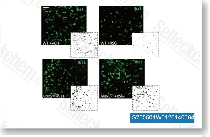
|
|
| S7171 | Setanaxib (GKT137831) | Setanaxib (GKT137831, GKT831) is a potent, dual NADPH oxidase NOX1/NOX4 inhibitor with Ki of 110 nM and 140 nM, respectively. This compound suppresses reactive oxygen species (ROS) production and partly inhibits ferroptosis. |
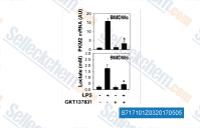
|
|
| S7309 | BAY 87-2243 | BAY 87-2243 is a potent and selective hypoxia-inducible factor-1 (HIF-1) inhibitor. This compound inhibits mitochondrial complex I activity, thus triggering a mitophagy-dependent ROS increase leading to necroptosis and ferroptosis. It exerts antitumor activity. Phase 1. |

|
|
| S1848 | Curcumin | Curcumin (Diferuloylmethane, Natural Yellow 3, Turmeric yellow) is the principal curcuminoid of the popular Indian spice turmeric, which is a member of the ginger family (Zingiberaceae). It is an inhibitor of p300 histone acetylatransferase(IC50~25 μM)and Histone deacetylase (HDAC); activates Nrf2 pathway and supresses the activation of NF-κB. This compound induces mitophagy, autophagy, apoptosis, and cell cycle arrest with antitumor activity. It reduces renal damage associated with rhabdomyolysis by decreasing ferroptosis-mediated cell death. This chemical exhibits anti-infective properties against various human pathogens like the influenza virus, hepatitis C virus, HIV and so on. |
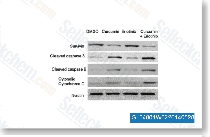
|
|
| S8661 | CA3 (CIL56) | CA3 (CIL56) has potent inhibitory effects on YAP1/Tead transcriptional activity and primarily targets YAP1 high and therapy-resistant esophageal adenocarcinoma cells endowed with CSC properties. It induces ferroptosis and iron-dependent reactive oxygen species (ROS). | ||
| S8078 | Bardoxolone Methyl | Bardoxolone Methyl (RTA 402, TP-155, NSC 713200, CDDO Methyl Ester, CDDO-Me) is an IKK inhibitor, showing potent proapoptotic and anti-inflammatory activities; Also a potent Nrf2 activator and nuclear factor-κB (NF-κB) inhibitor. This compound abrogates ferroptosis. It induces apoptosis and autophagy in cancer cells. |
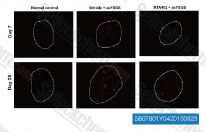
|
|
| S2505 | Rosiglitazone maleate | Rosiglitazone maleate, a member of the thiazolidinedione class of antihyperglycaemic agents, is a high-affinity selective agonist of the peroxisome proliferator-activated receptor-γ (PPAR-γ) with IC50 of 42 nM. This compound also modulates TRP channels and induces autophagy. It prevents ferroptosis. |
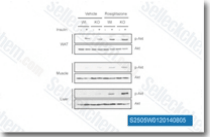
|
|
| S8254 | FIN56 | FIN56 is a specific inducer of ferroptosis . | ||
| S8877 | IKE (Imidazole Ketone Erastin) | IKE(Imidazole ketone erastin) is a potent, selective, and metabolically stable system xc– inhibitor and inducer of ferroptosis. | ||
| S3031 | Linagliptin (GSK2118436) | Linagliptin (GSK2118436) is a highly potent, selective DPP-4 inhibitor with IC50 of 1 nM and exhibits a 10,000-fold higher selectivity for DPP-4 than for other dipeptidyl peptidases such as DPP-2, DPP-8, and DPP-9. This compound activates glomerular autophagy in a model of type 2 diabetes. DPP4 mediates ferroptosis in TP53-deficient CRC cells. |
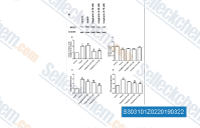
|
|
| S1576 | Sulfasalazine | Sulfasalazine is a sulfa derivative of mesalazine, used as an anti-inflammatory agent to treat bowel disease and rheumatoid arthritis. This compound is a potent and specific inhibitor of nuclear factor kappa B (NF-κB), TGF-β and COX-2. It induces ferroptosis, apoptosis and autophagy. | ||
| S1712 | Deferasirox | Deferasirox is an iron chelator, also a cytochrome P450 3A4 inducer, Cytochrome P450 2C8 inhibitor, and Cytochrome P450 1A2 inhibitor. This compound-induced iron depletion promotes BclxL downregulation and cell death. |
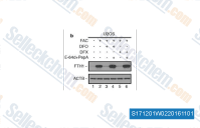
|
|
| S2046 | Pioglitazone HCl | Pioglitazone HCl (AD-4833, U-72107E) is an inhibitor of cytochrome P450 (CYP)2C8 and CYP3A4 enzymes. This compound inhibits CYP2C8, CYP3A4 and CYP2C9 with Ki of 1.7 μM, 11.8 μM and 32.1 μM, respectively. It is also a selective peroxisome proliferator-activated receptor-gamma (PPARγ) agonist with EC50 of 0.93 μM and 0.99 μM for human PPARγ and mouse PPARγ, respectively. This chemical inhibits mitochondrial iron uptake, lipid peroxidation, and subsequent ferroptosis. |
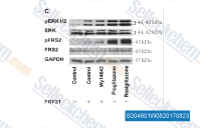
|
|
| S1443 | Zileuton | Zileuton is an orally active inhibitor of 5-lipoxygenase, and thus inhibits leukotrienes (LTB4, LTC4, LTD4, and LTE4) formation, used to decrease the symptoms of asthma. This compound induces apoptosis while inhibits ferroptosis. |
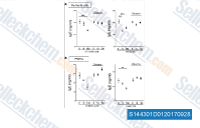
|
|
| S8792 | UAMC-3203 | UAMC-3203 is an improved ferroptosis inhibitor with an IC50 value of 10 nM in IMR-32 Neuroblastoma Cells. | ||
| S0788 | ML 210 | ML-210 (CID 49766530) is a selective covalent inhibitor of cellular glutathione peroxidase 4 (GPX4) with EC50 of 0.04 μM and induces ferroptosis. ML-210 can selectively kill cells induced to express mutant RAS. ML-210 exhibits anti-cancer activity. | ||
| S8432 | Troglitazone | Troglitazone is a potent agonist for the peroxisome proliferator-activated receptor-(PPAR) that is a ligand activated transcription factor regulating cell differentiation and growth. This compound induces autophagy, apoptosis and necroptosis in bladder cancer cells. It prevents RSL3-induced ferroptosis and lipid peroxidation in Pfa1 cells. | ||
| S4452 | ML162 | ML162 is a covalent inhibitor of cellular phospholipid glutathione peroxidase (GPX-4) that induces ferroptosis. | ||
| S9663 | iFSP1 | iFSP1 is a potent, selective and glutathione-independent inhibitor of ferroptosis suppressor protein 1 (FSP1/AIFM2) with EC50 of 103 nM. This compound selectively induces ferroptosis in GPX4-knockout Pfa1 and HT1080 cells that overexpresses FSP1.Solutions are unstable and should be fresh-prepared. | ||
| E0375 | Ammonium ferric citrate | Ammonium ferric citrate (Ferric ammonium citrate, Ammonium iron(III) citrate, Iron ammonium citrate, FerriSeltz) induces ferroptosis in non-small-cell lung carcinoma through the inhibition of GPX4-GSS/GSR-GGT axis activity. | ||
| S9840 | SRS16-86 | SRS16-86, a novel third-generation ferrostatin, is an inhibitor of ferroptosis. | ||
| S9839 | SRS11-92 | SRS11-92 (AA9), a Ferrostatin-1 (Fer-1) analogue, is a potent inhibitor of ferroptosis. This compound inhibits ferroptotic cell death induced by Erastin in HT-1080 human fibrosarcoma cells with EC50 of 6 nM. | ||
| S3984 | Nordihydroguaiaretic acid (NDGA) | Nordihydroguaiaretic acid (NDGA) is a phenolic antioxidant found in the leaves and twigs of the evergreen desert shrub, Larrea tridentata (Sesse and Moc. ex DC) Coville (creosote bush). It is a recognized inhibitor of lipoxygenase (LOX) and has antioxidant and free radical scavenging properties. This compound is a cytotoxic insulin-like growth factor-I receptor (IGF-1R)/HER2 inhibitor and induces apoptosis. | ||
| E1063 | Piperazine Erastin | Piperazine Erastin is an analog of Erastin, which can induces ferroptosis in cancer cells, an iron-dependent form of nonapoptotic cell death. | ||
| E1874 | Erastin2 | Erastin2 is an inducer of ferroptosis. It also selectively inhibits xc(-) cystine/glutamate transporter. It induces ferroptosis in HT-1080, T98G, and A549 cells with the potential to treat neurodegenerative diseases. | ||
| E1867 | NPD4928 | NPD4928 is an inhibitor of Ferroptosis Suppressor Protein 1 (FSP1) that enhances ferroptosis. It enhances the cytotoxic effects on various cell types when combined with GPX4 antagonists. | ||
| E1535 | icFSP1 | icFSP1 is a potent, selective human ferroptosis suppressor protein-1 (hFSP1) inhibitor, promotes ferroptosis and indirectly inhibits FSP1 by inducing condensate formation. | ||
| E4962New | Ferric citrate | Ferric citrate (Iron(III) citrate, Zerenex) is a Class 1 ferroptosis inducer and a safe, effective oral phosphate binder that increases iron stores and reduces the need for IV iron and erythropoiesis-stimulating agents while maintaining hemoglobin. It is approved for treating hyperphosphatemia in dialysis-dependent chronic kidney disease (CKD) and for iron deficiency anemia. | ||
| E1925 | Butylhydroxyanisole | Butylhydroxyanisole (Butylated hydroxyanisole, BHA, E320) is an inhibitor of ferroptosis, a food preservative and antioxidant that prevents the formation of harmful compounds, extending shelf life. However, it's associated with liver toxicity, reproductive organ development issues, learning delays, and sleep problems. | ||
| E1574 | FSEN1 | FSEN1 is a potent and non-competitive FSP1 inhibitor with an IC50 value of 313 nM. It triggers iron death in cancer cells by inhibiting FSP1 and can be used in research of cancer. | ||
| E1812 | N6F11 | N6F11 is an inducer of ferroptosis. This compound is bound to the RING domain of the E3 ubiquitin ligase tripartite motif containing 25 (TRIM25) in cancer cells to trigger TRIM25-mediated K48-linked ubiquitination of glutathione peroxidase 4 (GPX4), resulting in proteasomal degradation. | ||
| S7243 | Ferrostatin-1 (Fer-1) | Ferrostatin-1 (Fer-1) is a potent and selective inhibitor of ferroptosis with EC50 of 60 nM. |

|
|
| S7699 | Liproxstatin-1 | Liproxstatin-1 is a potent ferroptosis inhibitor with an IC50 of 22 nM. |

|
|
| S1077 | SB202190 | SB202190 is a potent p38 MAPK inhibitor targeting p38α/β with IC50 of 50 nM/100 nM in cell-free assays, sometimes used instead of SB 203580 to investigate potential roles for SAPK2a/p38 in vivo. This compound inhibits endothelial cell apoptosis via induction of autophagy and heme oxygenase-1. It significantly suppresses Erastin‐dependent ferroptosis. |

|
|
| S1623 | Acetylcysteine (N-Acetylcysteine, NAC) | Acetylcysteine (N-acetyl-l-cysteine, NAC,N-acetylcysteine) is a ROS(reactive oxygen species) inhibitor that antagonizes the activity of proteasome inhibitors. It is also a tumor necrosis factor production inhibitor. Acetylcysteine(N-acetyl-l-cysteine) suppresses TNF-induced NF-κB activation through inhibition of IκB kinases. Acetylcysteine(N-acetyl-l-cysteine) induces apoptosis via the mitochondria-dependent pathway. Acetylcysteine(N-acetyl-l-cysteine) inhibits ferroptosis and virus replication.Solutions are unstable and should be fresh-prepared. |

|
|
| S5742 | Deferoxamine mesylate | Deferoxamine mesylate is the mesylate salt of Deferoxamine, which forms iron complexes and is used as a chelating agent. Deferoxamine is a ferroptosis inhibitor that stabilizes HIF-1α expression and improves HIF-1α transactivity in hypoxic and hyperglycemic states in vitro. Deferoxamine decreases beta-amyloid (Aβ) deposition and induces autophagy.Please do not prepare stock solutions with normal saline or PBS, as precipitation may occur. | ||
| S2556 | Rosiglitazone | Rosiglitazone is a potent antihyperglycemic agent and a potent thiazolidinedione insulin sensitizer with IC50 of 12, 4 and 9 nM for rat, 3T3-L1 and human adipocytes, respectively. This compound is a pure ligand of PPAR-gamma, and has no PPAR-alpha-binding action. It modulates TRP channels and induces autophagy. It also prevents ferroptosis. |

|
|
| S7171 | Setanaxib (GKT137831) | Setanaxib (GKT137831, GKT831) is a potent, dual NADPH oxidase NOX1/NOX4 inhibitor with Ki of 110 nM and 140 nM, respectively. This compound suppresses reactive oxygen species (ROS) production and partly inhibits ferroptosis. |

|
|
| S1848 | Curcumin | Curcumin (Diferuloylmethane, Natural Yellow 3, Turmeric yellow) is the principal curcuminoid of the popular Indian spice turmeric, which is a member of the ginger family (Zingiberaceae). It is an inhibitor of p300 histone acetylatransferase(IC50~25 μM)and Histone deacetylase (HDAC); activates Nrf2 pathway and supresses the activation of NF-κB. This compound induces mitophagy, autophagy, apoptosis, and cell cycle arrest with antitumor activity. It reduces renal damage associated with rhabdomyolysis by decreasing ferroptosis-mediated cell death. This chemical exhibits anti-infective properties against various human pathogens like the influenza virus, hepatitis C virus, HIV and so on. |

|
|
| S8078 | Bardoxolone Methyl | Bardoxolone Methyl (RTA 402, TP-155, NSC 713200, CDDO Methyl Ester, CDDO-Me) is an IKK inhibitor, showing potent proapoptotic and anti-inflammatory activities; Also a potent Nrf2 activator and nuclear factor-κB (NF-κB) inhibitor. This compound abrogates ferroptosis. It induces apoptosis and autophagy in cancer cells. |

|
|
| S2505 | Rosiglitazone maleate | Rosiglitazone maleate, a member of the thiazolidinedione class of antihyperglycaemic agents, is a high-affinity selective agonist of the peroxisome proliferator-activated receptor-γ (PPAR-γ) with IC50 of 42 nM. This compound also modulates TRP channels and induces autophagy. It prevents ferroptosis. |

|
|
| S3031 | Linagliptin (GSK2118436) | Linagliptin (GSK2118436) is a highly potent, selective DPP-4 inhibitor with IC50 of 1 nM and exhibits a 10,000-fold higher selectivity for DPP-4 than for other dipeptidyl peptidases such as DPP-2, DPP-8, and DPP-9. This compound activates glomerular autophagy in a model of type 2 diabetes. DPP4 mediates ferroptosis in TP53-deficient CRC cells. |

|
|
| S2046 | Pioglitazone HCl | Pioglitazone HCl (AD-4833, U-72107E) is an inhibitor of cytochrome P450 (CYP)2C8 and CYP3A4 enzymes. This compound inhibits CYP2C8, CYP3A4 and CYP2C9 with Ki of 1.7 μM, 11.8 μM and 32.1 μM, respectively. It is also a selective peroxisome proliferator-activated receptor-gamma (PPARγ) agonist with EC50 of 0.93 μM and 0.99 μM for human PPARγ and mouse PPARγ, respectively. This chemical inhibits mitochondrial iron uptake, lipid peroxidation, and subsequent ferroptosis. |

|
|
| S1443 | Zileuton | Zileuton is an orally active inhibitor of 5-lipoxygenase, and thus inhibits leukotrienes (LTB4, LTC4, LTD4, and LTE4) formation, used to decrease the symptoms of asthma. This compound induces apoptosis while inhibits ferroptosis. |

|
|
| S8792 | UAMC-3203 | UAMC-3203 is an improved ferroptosis inhibitor with an IC50 value of 10 nM in IMR-32 Neuroblastoma Cells. | ||
| S8432 | Troglitazone | Troglitazone is a potent agonist for the peroxisome proliferator-activated receptor-(PPAR) that is a ligand activated transcription factor regulating cell differentiation and growth. This compound induces autophagy, apoptosis and necroptosis in bladder cancer cells. It prevents RSL3-induced ferroptosis and lipid peroxidation in Pfa1 cells. | ||
| S9840 | SRS16-86 | SRS16-86, a novel third-generation ferrostatin, is an inhibitor of ferroptosis. | ||
| S9839 | SRS11-92 | SRS11-92 (AA9), a Ferrostatin-1 (Fer-1) analogue, is a potent inhibitor of ferroptosis. This compound inhibits ferroptotic cell death induced by Erastin in HT-1080 human fibrosarcoma cells with EC50 of 6 nM. | ||
| S3984 | Nordihydroguaiaretic acid (NDGA) | Nordihydroguaiaretic acid (NDGA) is a phenolic antioxidant found in the leaves and twigs of the evergreen desert shrub, Larrea tridentata (Sesse and Moc. ex DC) Coville (creosote bush). It is a recognized inhibitor of lipoxygenase (LOX) and has antioxidant and free radical scavenging properties. This compound is a cytotoxic insulin-like growth factor-I receptor (IGF-1R)/HER2 inhibitor and induces apoptosis. | ||
| E1874 | Erastin2 | Erastin2 is an inducer of ferroptosis. It also selectively inhibits xc(-) cystine/glutamate transporter. It induces ferroptosis in HT-1080, T98G, and A549 cells with the potential to treat neurodegenerative diseases. | ||
| E1867 | NPD4928 | NPD4928 is an inhibitor of Ferroptosis Suppressor Protein 1 (FSP1) that enhances ferroptosis. It enhances the cytotoxic effects on various cell types when combined with GPX4 antagonists. | ||
| E1535 | icFSP1 | icFSP1 is a potent, selective human ferroptosis suppressor protein-1 (hFSP1) inhibitor, promotes ferroptosis and indirectly inhibits FSP1 by inducing condensate formation. | ||
| E1925 | Butylhydroxyanisole | Butylhydroxyanisole (Butylated hydroxyanisole, BHA, E320) is an inhibitor of ferroptosis, a food preservative and antioxidant that prevents the formation of harmful compounds, extending shelf life. However, it's associated with liver toxicity, reproductive organ development issues, learning delays, and sleep problems. | ||
| E1574 | FSEN1 | FSEN1 is a potent and non-competitive FSP1 inhibitor with an IC50 value of 313 nM. It triggers iron death in cancer cells by inhibiting FSP1 and can be used in research of cancer. | ||
| S1166 | Cisplatin | Cisplatin is an inorganic platinum complex, which is able to inhibit DNA synthesis by conforming DNA adducts in tumor cells. Cisplatin activates ferroptosis and induces autophagy.Solutions are unstable and should be fresh-prepared.DMSO is not recommended to dissolve platinum-based drugs, which can easily lead to drug inactivation. |

|
|
| S7397 | Sorafenib (BAY 43-9006) | Sorafenib is a multikinase inhibitor of Raf-1 and B-Raf with IC50 of 6 nM and 22 nM in cell-free assays, respectively. Sorafenib inhibits VEGFR-2, VEGFR-3, PDGFR-β, Flt-3 and c-KIT with IC50 of 90 nM, 20 nM, 57 nM, 59 nM and 68 nM, respectively. Sorafenib induces autophagy and apoptosis and activates ferroptosis with anti-tumor activity. |

|
|
| S2111 | Lapatinib | Lapatinib is a potent EGFR and ErbB2 inhibitor with IC50 of 10.8 and 9.2 nM in cell-free assays, respectively. This compound induces ferroptosis and autophagic cell death. |

|
|
| S1040 | Sorafenib tosylate | Sorafenib tosylate is a multikinase inhibitor of Raf-1 and B-Raf with IC50 of 6 nM and 22 nM in cell-free assays, respectively. This compound inhibits VEGFR-2, VEGFR-3, PDGFR-β, Flt-3 and c-KIT with IC50 of 90 nM, 20 nM, 57 nM, 59 nM and 68 nM, respectively. It induces autophagy and apoptosis and activates ferroptosis with anti-tumor activity. |

|
|
| S1007 | Roxadustat (FG-4592) | Roxadustat (FG-4592) is an HIF-α prolyl hydroxylase inhibitor in a cell-free assay, stabilizes HIF-2 and induces EPO production. Roxadustat potentiates RSL3 induced ferroptosis. Phase 3. |

|
|
| S1792 | Simvastatin | Simvastatin is a competitive inhibitor of HMG-CoA reductase with Ki of 0.1-0.2 nM in cell-free assays. Simvastatin induces ferroptosis, mitophagy, autophagy and apoptosis. |

|
|
| S7309 | BAY 87-2243 | BAY 87-2243 is a potent and selective hypoxia-inducible factor-1 (HIF-1) inhibitor. This compound inhibits mitochondrial complex I activity, thus triggering a mitophagy-dependent ROS increase leading to necroptosis and ferroptosis. It exerts antitumor activity. Phase 1. |

|
|
| S8661 | CA3 (CIL56) | CA3 (CIL56) has potent inhibitory effects on YAP1/Tead transcriptional activity and primarily targets YAP1 high and therapy-resistant esophageal adenocarcinoma cells endowed with CSC properties. It induces ferroptosis and iron-dependent reactive oxygen species (ROS). | ||
| S8254 | FIN56 | FIN56 is a specific inducer of ferroptosis . | ||
| S1576 | Sulfasalazine | Sulfasalazine is a sulfa derivative of mesalazine, used as an anti-inflammatory agent to treat bowel disease and rheumatoid arthritis. This compound is a potent and specific inhibitor of nuclear factor kappa B (NF-κB), TGF-β and COX-2. It induces ferroptosis, apoptosis and autophagy. | ||
| S1712 | Deferasirox | Deferasirox is an iron chelator, also a cytochrome P450 3A4 inducer, Cytochrome P450 2C8 inhibitor, and Cytochrome P450 1A2 inhibitor. This compound-induced iron depletion promotes BclxL downregulation and cell death. |

|
|
| S0788 | ML 210 | ML-210 (CID 49766530) is a selective covalent inhibitor of cellular glutathione peroxidase 4 (GPX4) with EC50 of 0.04 μM and induces ferroptosis. ML-210 can selectively kill cells induced to express mutant RAS. ML-210 exhibits anti-cancer activity. | ||
| S4452 | ML162 | ML162 is a covalent inhibitor of cellular phospholipid glutathione peroxidase (GPX-4) that induces ferroptosis. | ||
| S9663 | iFSP1 | iFSP1 is a potent, selective and glutathione-independent inhibitor of ferroptosis suppressor protein 1 (FSP1/AIFM2) with EC50 of 103 nM. This compound selectively induces ferroptosis in GPX4-knockout Pfa1 and HT1080 cells that overexpresses FSP1.Solutions are unstable and should be fresh-prepared. | ||
| E0375 | Ammonium ferric citrate | Ammonium ferric citrate (Ferric ammonium citrate, Ammonium iron(III) citrate, Iron ammonium citrate, FerriSeltz) induces ferroptosis in non-small-cell lung carcinoma through the inhibition of GPX4-GSS/GSR-GGT axis activity. | ||
| E1812 | N6F11 | N6F11 is an inducer of ferroptosis. This compound is bound to the RING domain of the E3 ubiquitin ligase tripartite motif containing 25 (TRIM25) in cancer cells to trigger TRIM25-mediated K48-linked ubiquitination of glutathione peroxidase 4 (GPX4), resulting in proteasomal degradation. | ||
| S8790 | ML385 | ML385 is a novel and specific NRF2 inhibitor with an IC50 of 1.9 μM. It inhibits the downstream target gene expression of NRF2. This compound regulates the activity of several ferroptosis and lipid peroxidation-related proteins. | ||
| E4962New | Ferric citrate | Ferric citrate (Iron(III) citrate, Zerenex) is a Class 1 ferroptosis inducer and a safe, effective oral phosphate binder that increases iron stores and reduces the need for IV iron and erythropoiesis-stimulating agents while maintaining hemoglobin. It is approved for treating hyperphosphatemia in dialysis-dependent chronic kidney disease (CKD) and for iron deficiency anemia. |






































